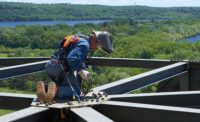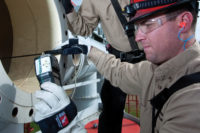QUESTION:
What atmospheric conditions need to be tested prior to confined space entry, and how can I be sure it is safe to enter?ANSWERS:
Prior to working in any confined space, OSHA stipulates that the area must be evaluated prior to entry and continuously during entries with a calibrated gas monitor. The specific gas hazards that need to be monitored are oxygen content, combustible gases, and any other toxic gas that is a by-product of that specific industry or process.The most typical toxic gases monitored are carbon monoxide and hydrogen sulfide, but other toxic gases include ammonia, chlorine and hydrogen cyanide (just to name a few). Pre-entry testing is accomplished using a remote sampling pump with external tubing or probes. If the levels in the confined space do not exceed the recommended OSHA minimum limits, the worker can enter the area. Once in the confined space, samples must be taken continuously in four-foot increments in the direction of travel.
Matthew Thiel, General Product Manager, Industrial Scientific Corp.
Confined space entry procedures are defined in Department of Labor-OSHA regulation 29CFR 1910.146 “Permit-required confined spaces.†Atmospheric hazards to be tested for include oxygen content, flammable gases and vapors, and toxic air contaminants.
The most common cause of death from atmospheric hazards in confined spaces is asphyxiation due to lack of oxygen. Flammable gases and vapors, if present, could be ignited and result in a fire or explosion. Toxic gases and vapors present a health hazard to entrants if not remedied, or if the proper protective equipment is not used. Testing equipment must be appropriate for the potential hazard that could be encountered, and proper working condition of the test equipment should be verified prior to each use.
Bruce Holcom, Business Development Manager, RKI Instruments, Inc.
The first step would be to study the space — e.g., a city sewer, a gasoline storage tank, a chemical storage tank — and determine the possible hazards.
Step two would be to assume the worst-case scenario and test for all the possibilities with a four-gas meter. Test for oxygen deficiency, flammables, hydrogen sulfide, and carbon monoxide. Testing should be done at least at three different levels of the confined space to allow for pockets of gas that may be present. If at all possible, check at more than one location in the space. If the confined space is deep, a sample drawing pump should be used to draw samples from deep locations. The instrument should be calibrated daily to assure accuracy.
Step three, keep the meter running at all times during occupancy.
Step four, enter the space with an airline respirator and review the entire space for hazards before going off the airline respirator.
Step five, maintain fresh air ventilation during the entire work process in the confined space.
Dave Angelico, President, Air Systems International, Inc.
The actual entry into a permit-required confined space should be seen as the final stage in a lengthy process. According to CFR 1910.146, the employer is required to assess the specific risks of confined spaces in the workplace and come up with a written plan to ensure acceptable entry conditions. When it comes to the atmosphere, the assessment of risk includes determining which toxic gases could accumulate in the confined space. Once the potential toxic gases have been determined, OSHA requires that the atmosphere inside the confined space be tested for oxygen content, flammable gases and vapors, and any toxic gases that might be present (in that order).
Matthew Holmquist, Senior Technical Writer, Biosystems, A Bacou-Dalloz Company
The permit-required confined space standard is a performance-oriented standard that places the focus on employer evaluation of all atmospheric hazards rather than relying on the instrument designer. Thousands of handheld “four-gas†instruments are sold each year as: 1) oxygen, 2) combustible (methane), 3) carbon monoxide and 4) hydrogen sulfide. Yet OSHA’s only specifically stated required measurement is for oxygen level between 19.5 percent and 23.5 percent by volume; methane, CO and H2S are not found in the regulation as specific gas hazards of all confined spaces.
The best answer is: “Oxygen level plus any flammable above 10 percent of its LEL or toxic substance above PEL as known or suspected by the employer to be present, or which could be generated by work in the confined space.â€
Verne R. Brown, Ph.D., President, ENMET Corp.
Confined spaces typically will have three types of gas-related risks: 1) explosive due to combustible levels of hydrogen or methane and other hydrocarbon vapors; 2) toxic levels of carbon monoxide (CO) and hydrogen sulfide (H2S); and 3) oxygen deficiency due to displacement of the breathable air levels with other gases.
Before entry to a confined space, the operator should use a four-gas continuously monitoring portable gas detector to sample the air within the entry point. This is usually done by lowering a sample tube into the manhole and taking the gas readings before any staff enter; the portable will measure the pumped airflow.
Assuming the readings are all in the safe area of detection, the operators can then enter the confined space. Since many trenches, tunnels and other plant infrastructure can trap pockets of dangerous gas, the user should also ideally continue to wear a personal four-gas detector all the time, so as to remain aware of any hazardous locations.
By calibrating or “bump testing†the portable gas detector with a certified multi-mix gas cylinder before the entry process, the user can be confident that the device will be ready to raise an audible and visible alarm if there are dangerous levels of flammable and/or toxic gases or insufficient breathable oxygen.
Patrick Hogan, Ph.D., Director of Business Development, Portables, Zellweger Analytics
When dealing with confined space, one should realize it is dangerous to work alone. Approaching the space, it should be determined that there is a sufficient oxygen supply, either from the natural air or from a self-contained breathing apparatus. Then, the space should be tested to make sure there are no gases present at an explosive level. Finally, the crew should test for toxic gases, including carbon monoxide and hydrogen sulfide. After the presence of oxygen has been confirmed, the presence of explosive and rapidly toxic environments has been determined, and an egress identified, the confined space can be entered.
Jim Norgaard, Vice President Product Development, Photovac, Inc.
This is dependant upon the outcome of the required risk and hazard assessment.
A “pre-entry check†at various levels is required since some gases tend to accumulate at floor-level, mid-level or ceiling-level due to their molecular weight. It’s essential that any entrance barriers, such as manhole covers, are not removed prior to the check, in order to preserve the gas mixture inside the space.
The recommended sampling method is to use a calibrated “direct read†monitor equipped with an electrical sampling pump and appropriate sensors for the determined potential hazards. It’s important to use inert (non-absorbing) accessories (probes, sampling lines) to ensure reliable results when readily absorbing gases (such as H2S) are involved.
If the pre-entry test does not reveal any atmospheric hazards, then entry into the confined space may proceed.
Keshwar Anroedh, Product Line Manager, MSA Portable Instruments
The atmospheric hazards associated with a particular confined space depend on the type and nature of the space, the work being performed and the materials being used during the confined space entry procedures. Atmospheric monitoring should always reflect the specific hazards associated with the environment and the job. Testing should always include assessing how much oxygen is present in the space. Anything other than 20.9 percent indicates that the atmosphere contains something besides the components found in clean, fresh air. Too little oxygen indicates the presence of a dangerous oxygen deficiency, but low oxygen may also prevent a combustible sensor from operating properly.
Once it has been determined that the oxygen is high enough for the combustible sensor to detect gas, the next step is to test for the presence of combustible gases and vapors. The next step is to check for the presence of any toxic gases and vapors, like CO and H2S, that may be potentially present. The final step is to continue to test the atmosphere for the entire time that entrants are in the confined space.
Robert E. Henderson, Vice President, Business Development, BW Technologies

